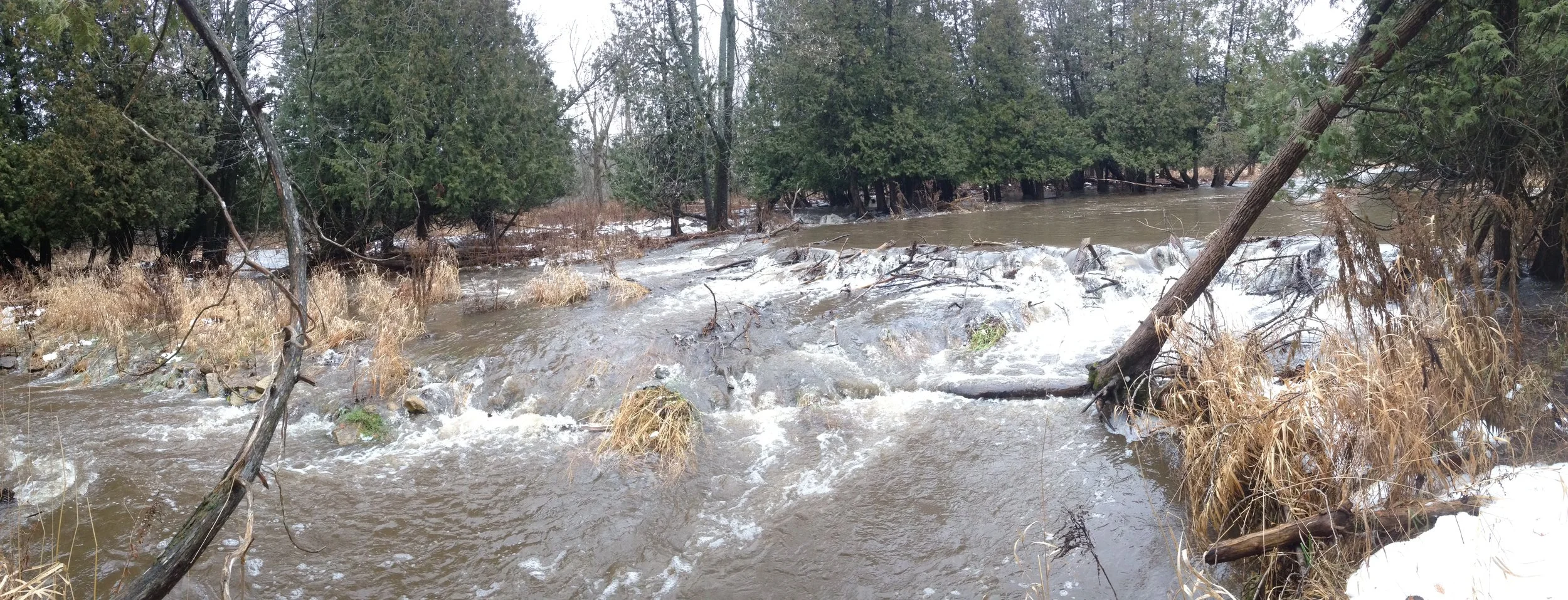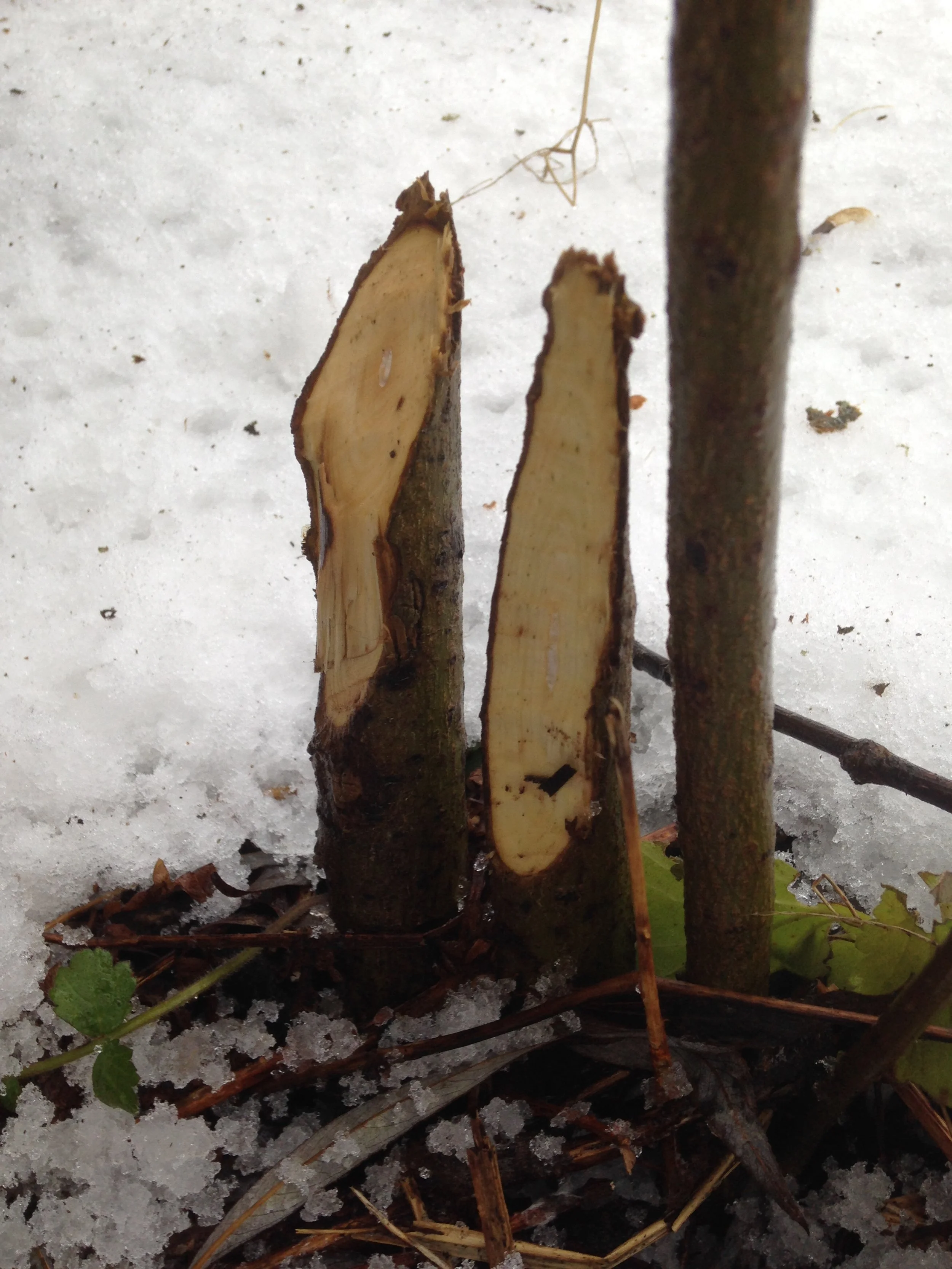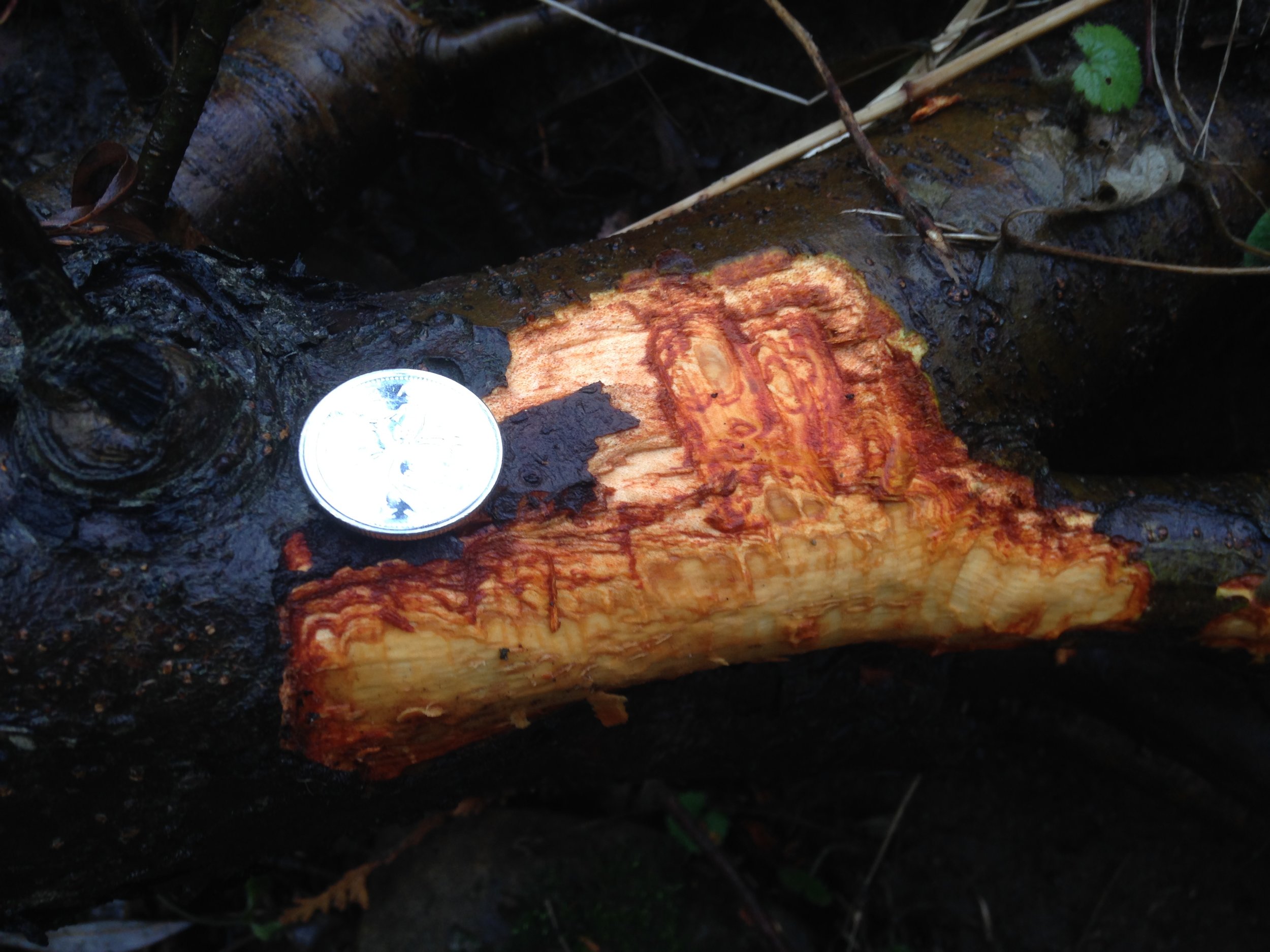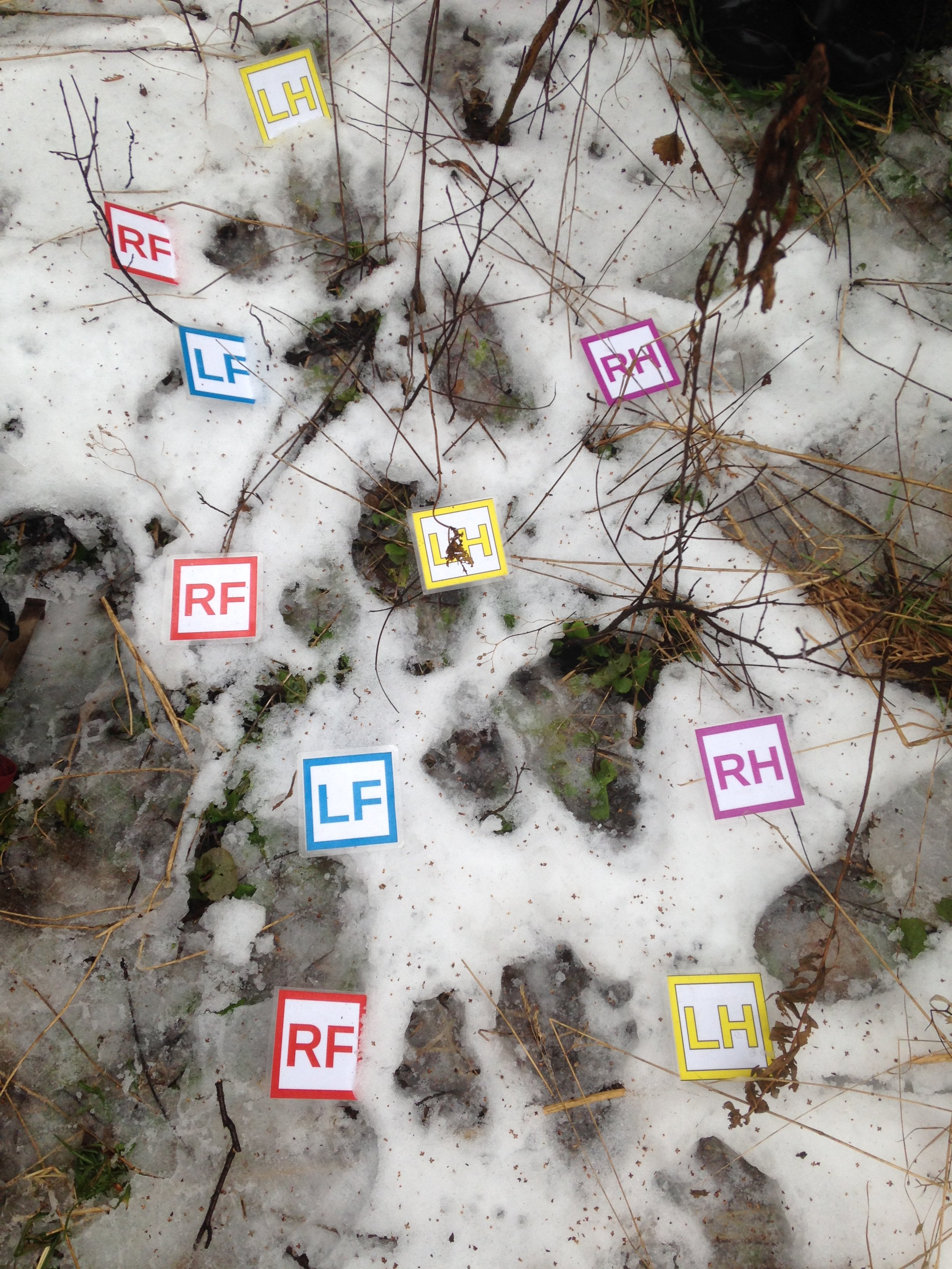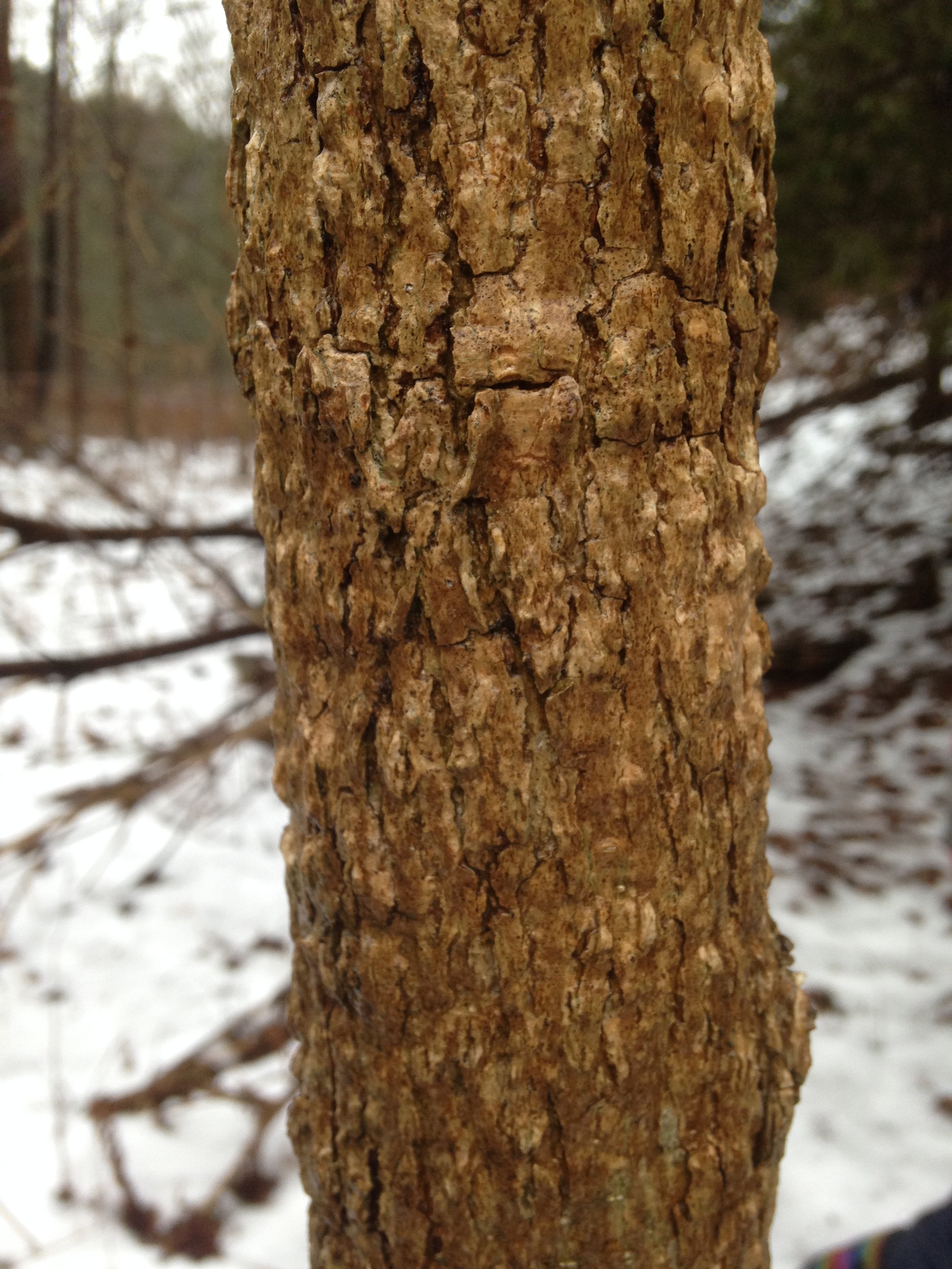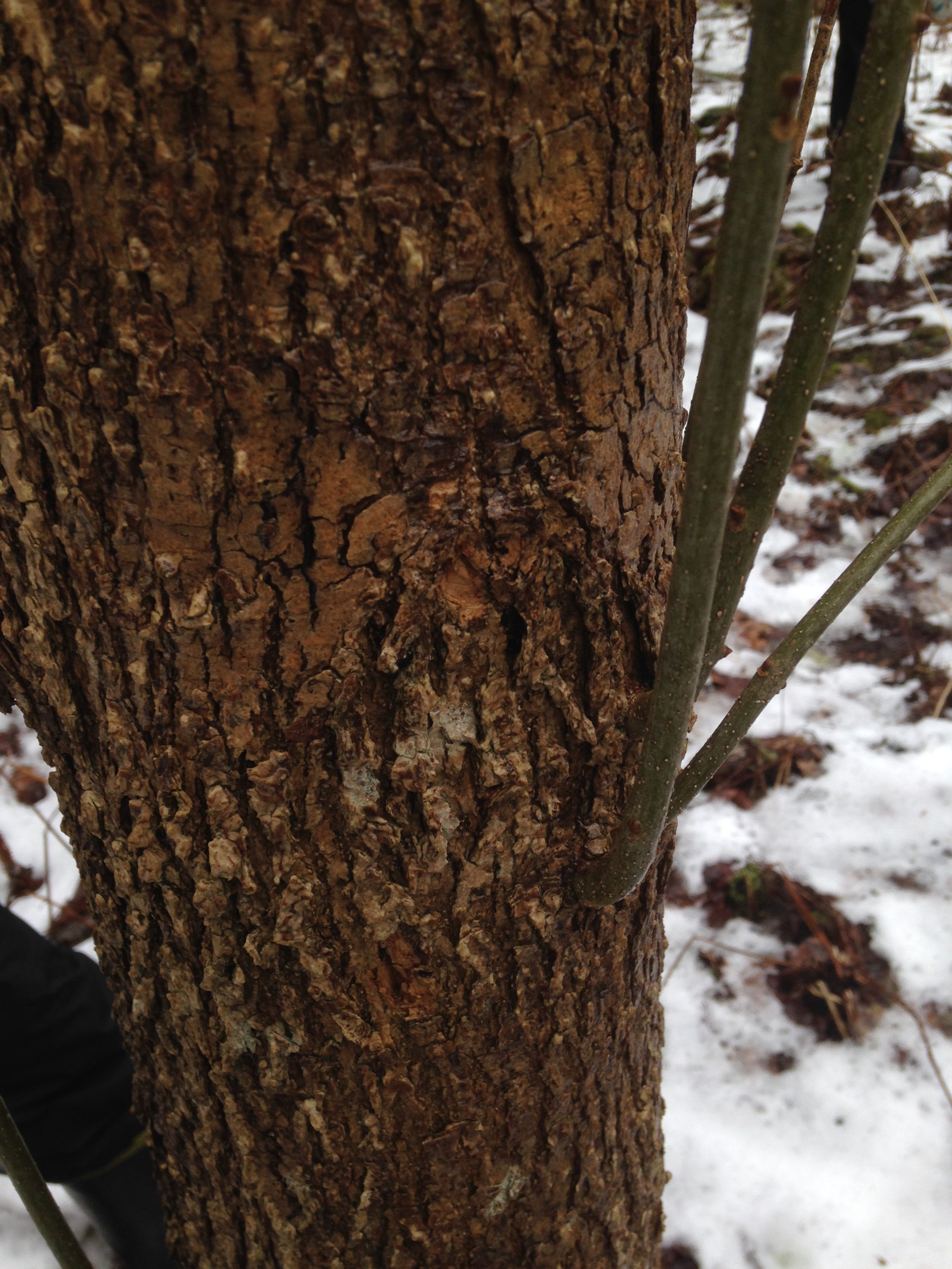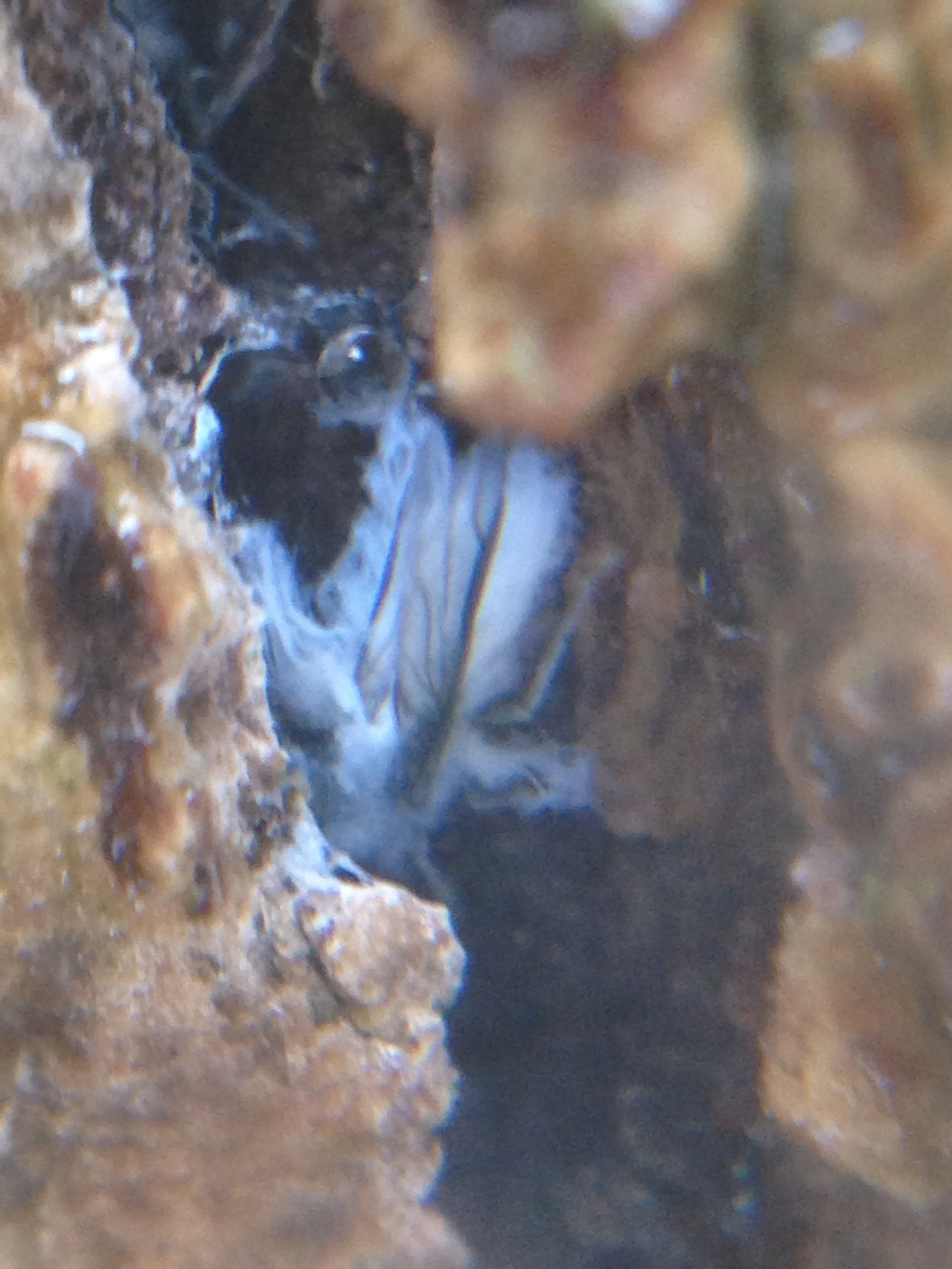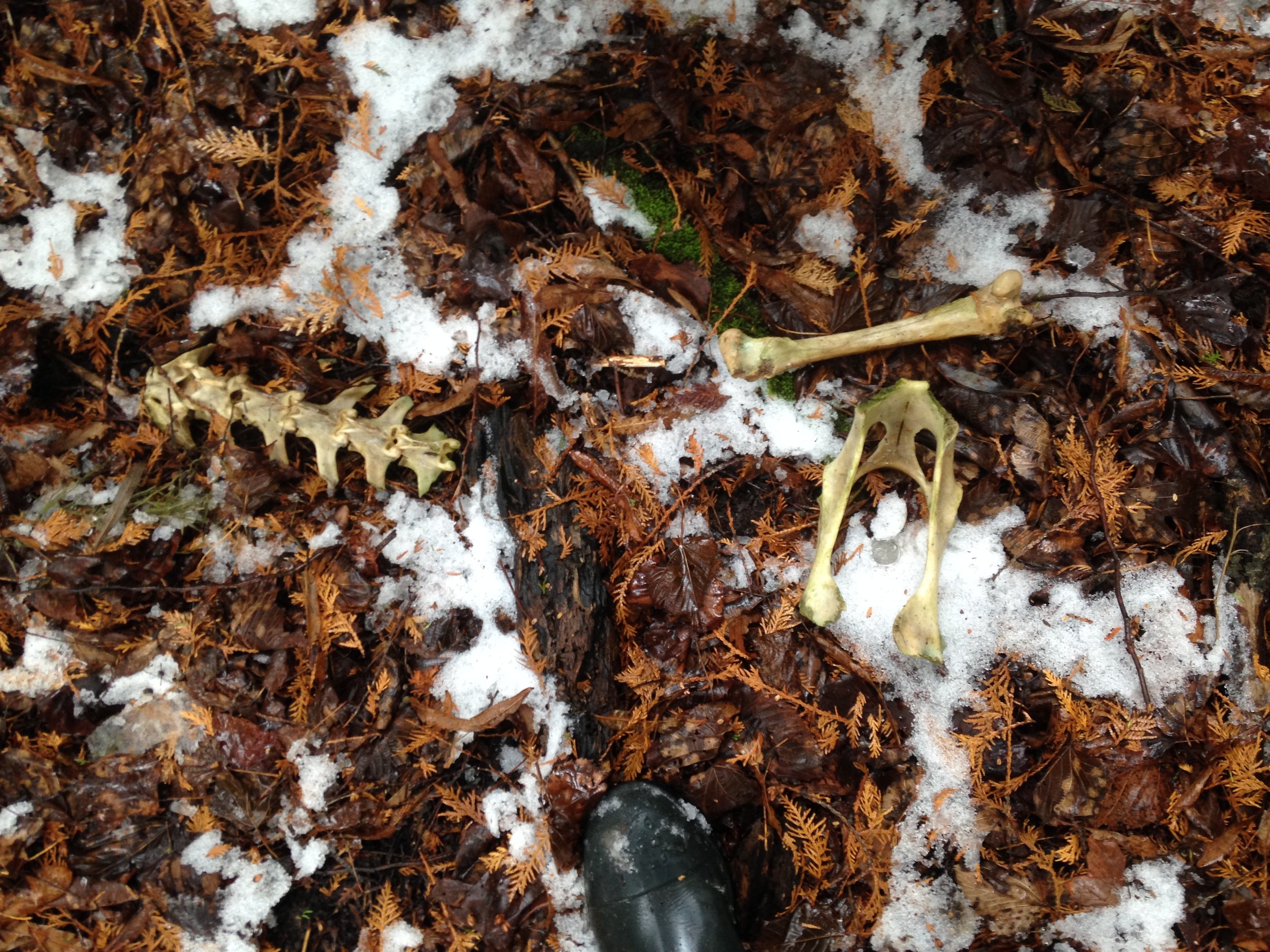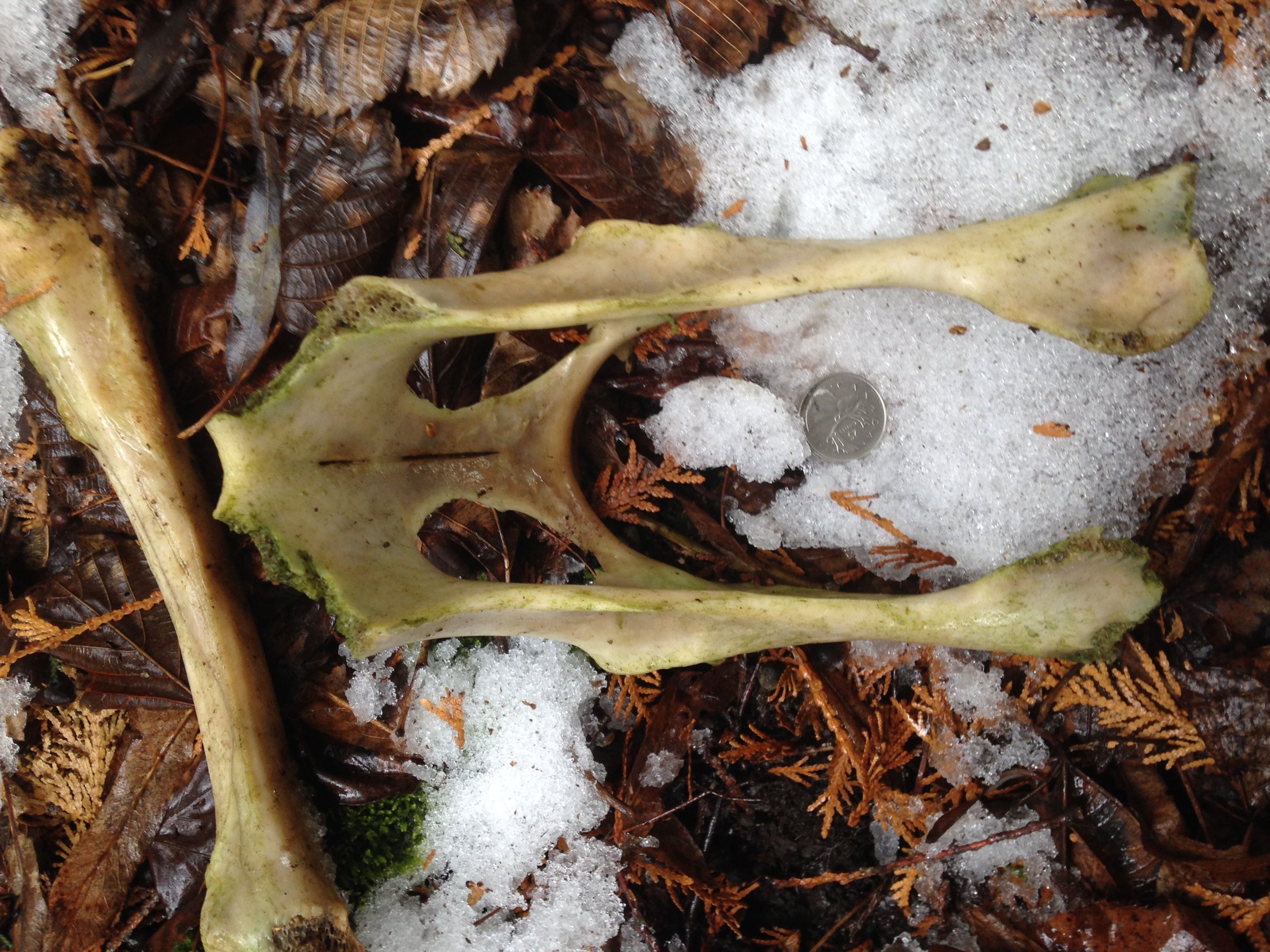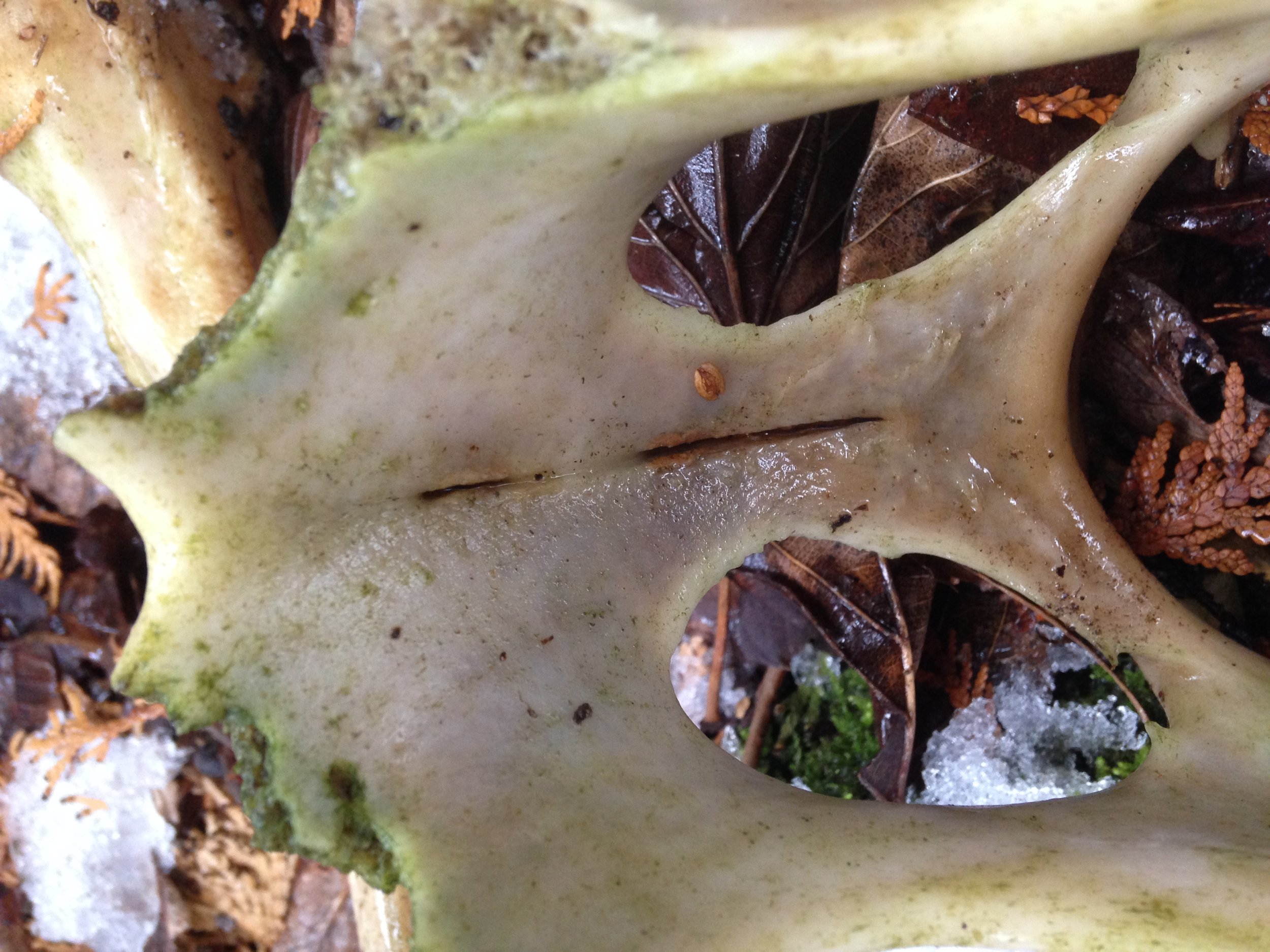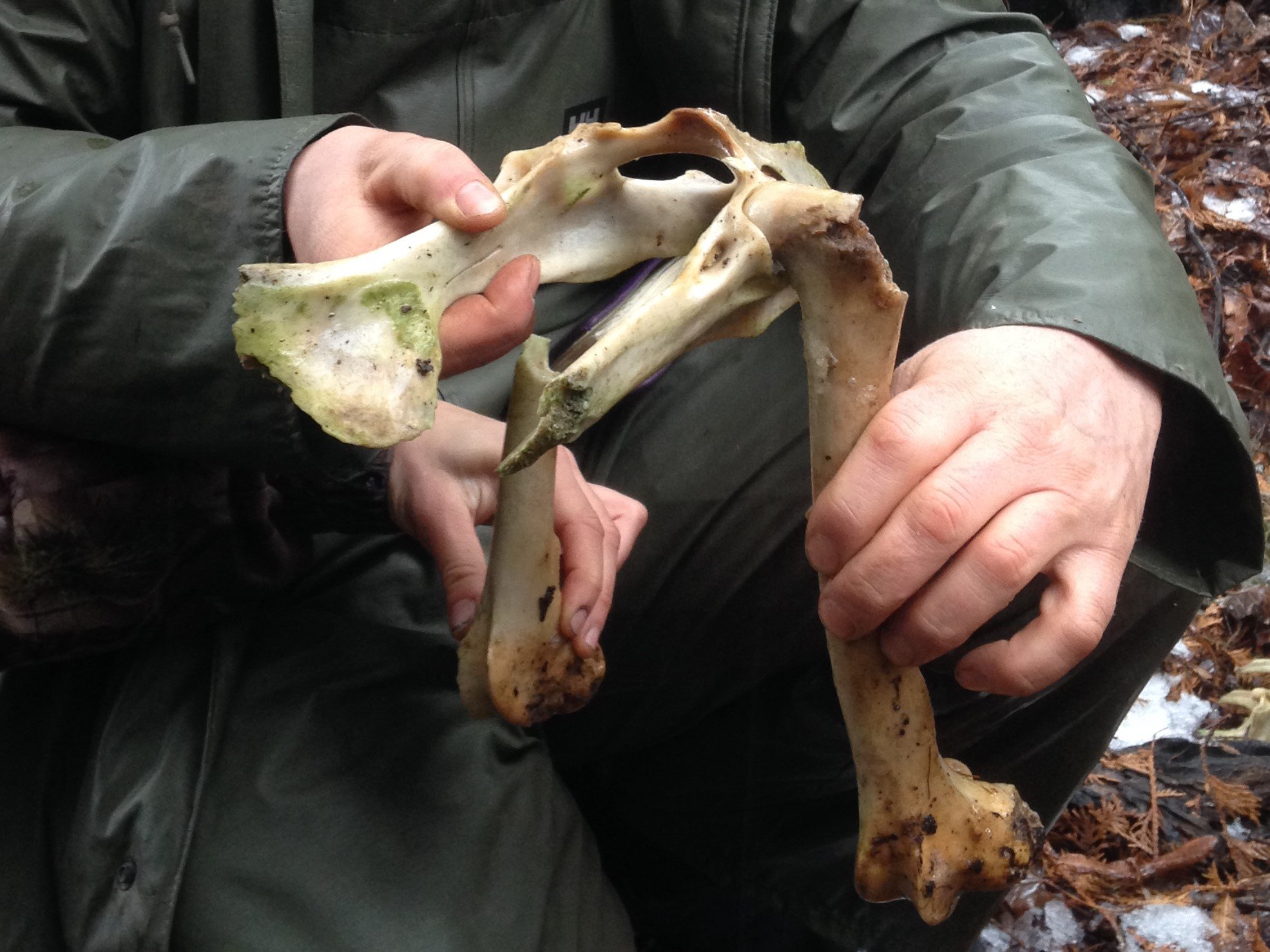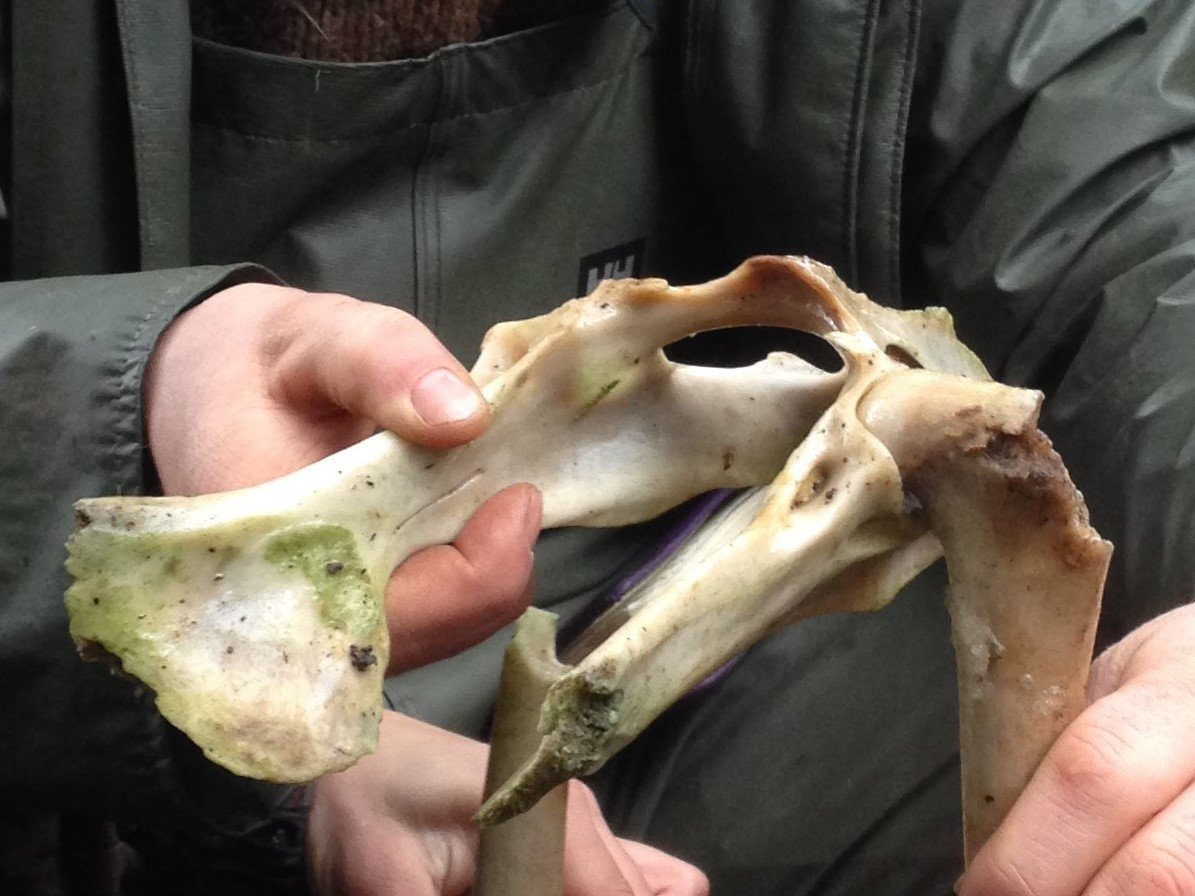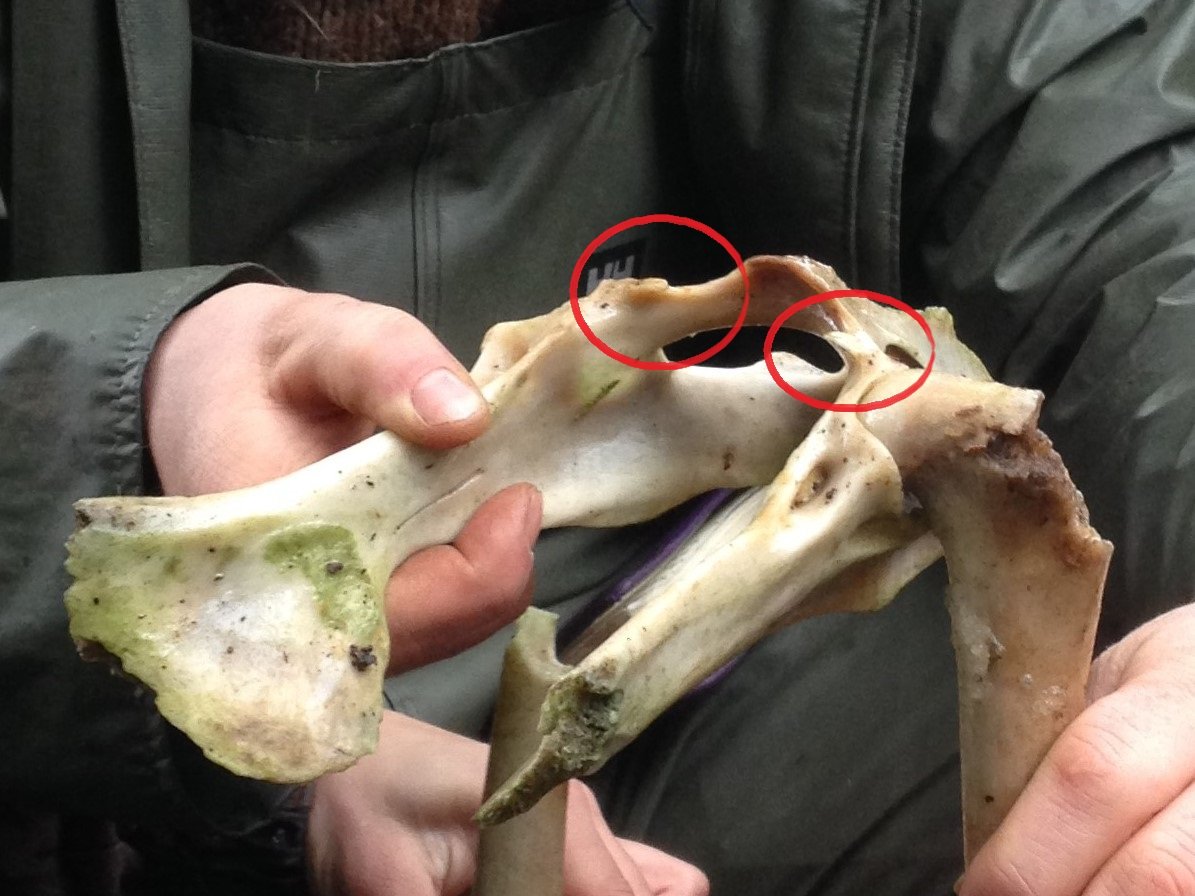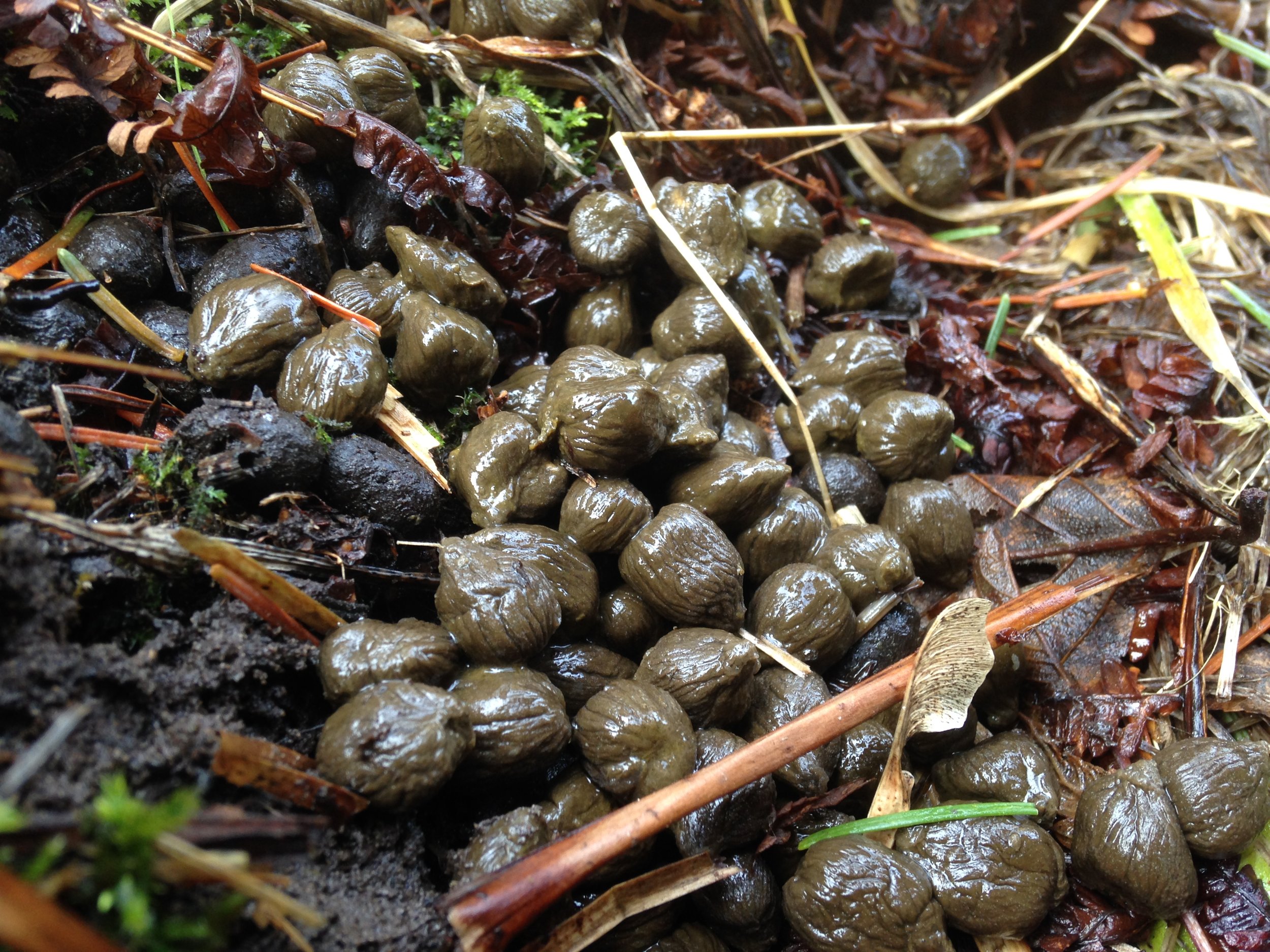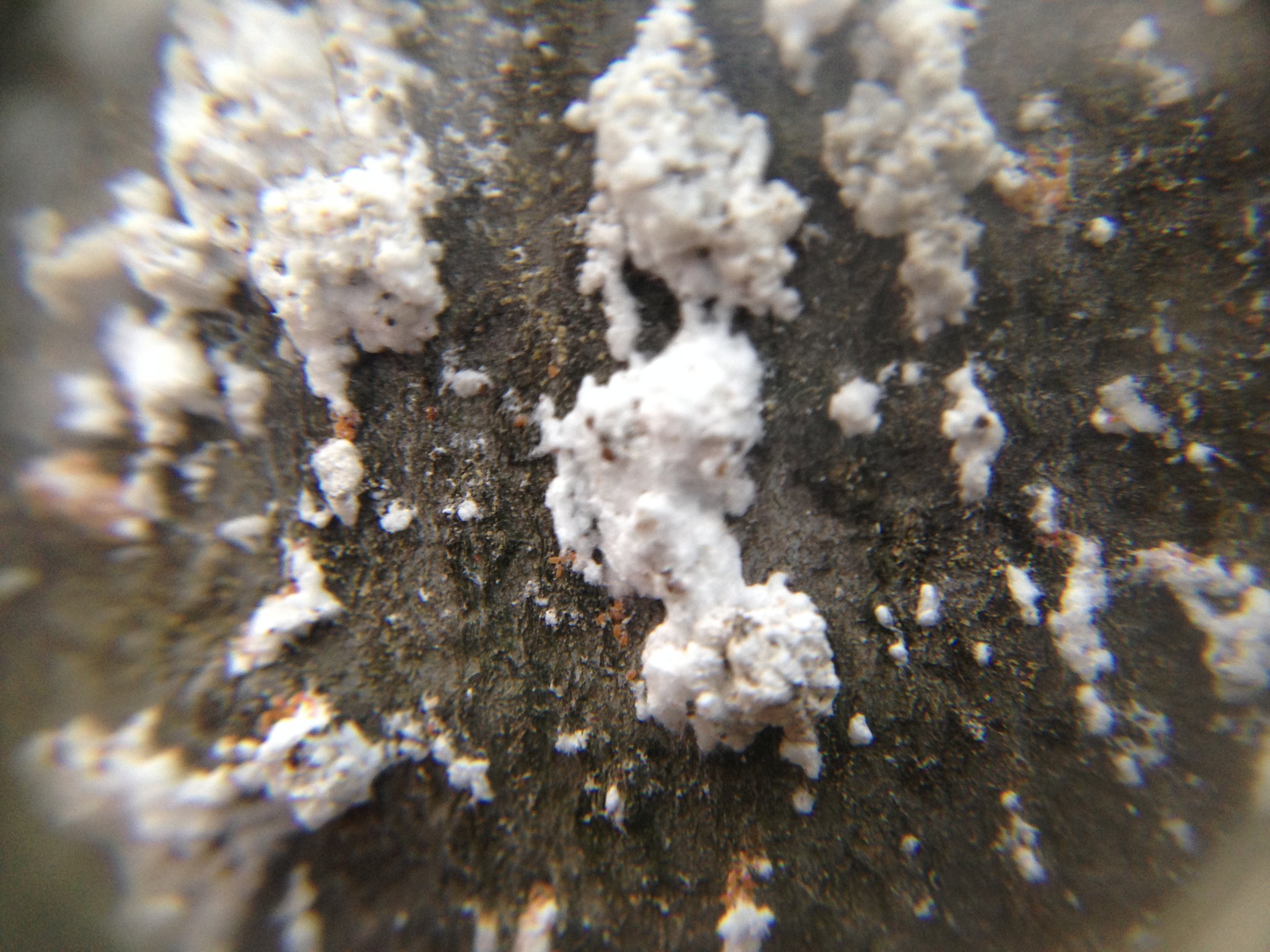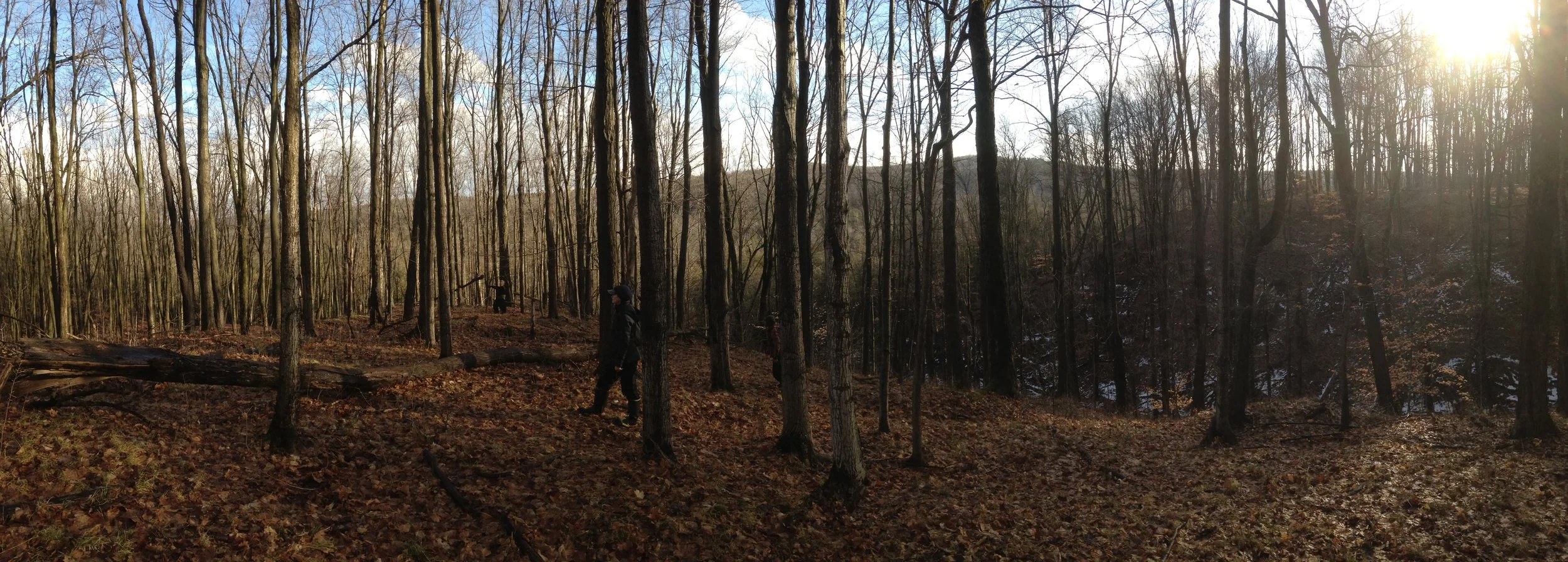Boyne Valley Tracking Journal, 11.12.2021
Dec 9th : Snowfall in evening and overnight.
Dec 10th : High of 4 or 5, sun and cloud, rained overnight.
Dec 11th : Low of 1°C, High of 15°C. At 2pm, winds were from the West, 43 kmph with gusts up to 76 kmph. Mostly overcast, though some sun and some rain throughout the day.
Once the two of our crew had returned from bringing a car to the next road over, we began our journey through the Boyne Valley, North of Orangeville. I had been there before. The last time was 2019 with my second year of the apprenticeship. It was a great place for trailing White Tailed Deer (Odocoileus virginianus) and was the first place I had ever seen Northern River Otter (Lontra canadensis) tracks. I was stoked to be back.
As we made our way down from the parking lot the first thing I had noticed was the river. It was full and moving quickly. It had been warm the day before, melting a lot of the snow which had fallen, and rained that night, making for a rushing river. We could see it was high and moving quickly. As we came down the steep hill towards the river we noticed something else.
Someone had been tearing up the dead Teasel (Dipsacus fullonum) stalks. I had observed a bird who liked to go after the seeds of non-native plants in the cooler months before, but didn’t know for sure who this was. So we all took a guess. American Goldfinch (Spinus tristis)? We had no way of knowing for certain, but it seemed to everyone that this was the likely choice. The European Goldfinch (Carduelis carduelis) who is in the same subfamily (Carduelinae) as S. tristis is also known to feed on Teasel, which is a native of Eurasia/North Africa. While AMGO’s do sometimes consume aphids and caterpillars, they are dominantly seed eaters. They fit the bill. Rachelle also brought up the possibility of a Crossbill (Loxia spp.) which does seem to be a consumer of Teasel seeds as well. From what I understand there are two species of Crossbill who lives in our area, Red Crossbill (L. curvirostra) and the Two-Barred Crossbill (L. leucoptera) so either of them could have been the seed eater in question as well.
We noticed that the seeds we very small, and I even tasted a couple to see if there was anything noticeable in their taste, but I didn’t pick up anything noteworthy. There were a lot of seeds though, and my research (John Eastman, 2003) tells me that there can be up to 3000 seeds per plant, which could be a real feast in the middle of Winter for a bird in need. Eastman also writes that the Teasel seeds are generally spread by water on this continent, and that could likely be why we found the plant so close to the river. What a good find to start the day.
I am unsure who made the next discovery but it was a good one. About 1.3 m (51 3/16 in) high up a branch extended from a tree. As I came close Rachelle was replacing the scat. It looked like she may have found a small hair in the end of it and picked it up for a closer examination. I looked at it and took a guess before really thinking to much about. My guess was based on a discovery from a couple of years ago of some scat beside some old frozen Apples (Malus domestica) in a thicket. There were Grey Squirrel tracks all around (Sciurus carolinensis) and I realized it was the first time I had really seen Grey Squirrel scat. It was tubular and a little less than half a centimeter thick. This scat looked just like it, and seeing how it was up in a tree, it thought I would throw it out there. The scat in the tree 7mm long x 3mm in diameter. In Mammal Tracks and Sign, Mark Elbroch describes Grey Squirrel scat as .3 - .6 cm (1/8” - 7/32”) in diameter x .4 - 1 cm (5/32” - 3/8”) long, so this pellet seemed right in that window. We wondered a little about Grey vs Red Squirrel scat, but I don’t think anyone knew what we should be looking for. My research indicates that Red Squirrel scat is about the same size, and could be just as tubular though both species scat is variable and changes with diet. It helps to remember that as the sphincter of the anus closes it pinches off the end of the scat creating the taper, and since the anus is most often facing the direction where an animal has come from, the tapered end of some scat may indicate direction of travel. There was more scat from a different animal at the base of the same tree, but I want to move along as it was a big day and I can’t write about everything.
Various signs and tracks were littering the riverside. We had to watch where we stepped at some points we might step on a track, or step past some spoor which might teach us about who is in relationship with this place. One sign we took note of was some strange cuts at the base of a missing tree.
They looked like Beaver (Castor canadensis) to me, but some folks were noting that the cuts were angled at about 75°, which is could be pretty steep for a Beaver chew. There was also the peculiar consideration that one of the fallen mini-trunks was snapped off on one end which isn’t as common as a straight chew could be. There were many other signs that surely confirmed the Beaver near by, like other chews on other stumps, roots and twigs, Beaver tracks leading to and from the chews, worn troughs on the bank between the river and the trees, and finally the tell-tale “steps” left behind on the cuts. These steps are created when the Beaver anchors their upper incisors on the limb to be chewed, and then proceeds to bite in with their lower incisor, slicing through the bark and inner wood. Note I wrote “lower incisor” nor incisors. Singular. According to the 1868 book “The American Beaver” by Lewis H. Morgan, “a single tooth is used at a time, the other following in the space made by the previous bite”. As they chew like this, they are also moving their heads across the length of the branch they are ripping apart as we might with a cob of Corn. They then go over the previous length with the other lower incisor. This was news to me when I read this, and now I want to be looking more closely at the chips left behind.
I think I, we, need to trust the animals more than my/our expectations of them. What I mean is that sometimes the animals we know or think we know, may show behaviours, or signs of behaviours that run a little varied to the experiences we’ve had with them. This, instead of hindering me can instead enlighten me, teach me new things about this particular individual and how they interact with their world around them. Does this trunk snap at the base before being entirely chewed off because this particular Beaver like to straddle the tree while chewing? Does this Beaver have a funny set of incisors so their chews must be executed at a stranger angle? Did they just get impatient and snap the twig like I sometimes do when sawing something? The variations in sign can help us distinguish various personalities within the environment we are encountering. These unique signs also broaden our expectations of how Beavers will act in the future, allowing us to see what we may have been blind to before. Variation is the foundation of personality and individuality. Variations can be signatures on the landscape and we should take note as we find them.
(Three images above, (1) chews on Apple (Malus domesticus) root, (2) single right hind track, and (3) an unknown gait pattern with left and right fronts and hinds identified.)
As we continued walking, and by that I mean only a couple feet away, we noticed some different trees growing along the river bank. There were Pagoda Dogwoods (Cornus alternafolia), an Apple (Malus domesticus), a few Eastern White Cedars (Thuja occidentalis), but there was one we took a longer look at. The tree was tall and slender, pale corky bark, appeared to be oppositely branching, with a dark brown terminal bud that reminds me of a chocolate chip glued to end of the twig. There were also oppositely positioned lateral buds just set back from the terminal bud. Finally, a good give-away was that it was growing in a pretty wet place alongside the river, where I could imagine it could get a little flooded in the Spring.
It was Black Ash (Fraxinus nigra), also called Swamp Ash, or Water Ash. This was a great tree to find as it can be uncommon, and is also under pressure from the Emerald Ash Borer (Agrilus planipennis). We could see some shoots coming from the trunk of the tree about waist high, up to just above our heads. These shoots are sent out by the tree when they are under stress. The Emerald Ash Borer larvae feed between the sapwood and bark and it’s this feeding that cuts off the flow of nutrients, which eventually kills the tree.
Some information on Ash i.d. can be remembered with a simple rhyme.
White is tight, Black is slack.
Red and Green are in between.
Blue is square, and Pumpkin rare!
White Ash (F. americana) has a terminal bud that sits very close (tight) to the lateral buds, where as black is a little looser (slack), with lateral buds that sit a little further back from the terminal bud. Red and Green, (F. pennsylvanica) now considered the same species, aren't too different from White Ash, but can often be differentiated by where they are growing (F. americana prefer uplands, F. pennsylvanica prefer lowlands). Blue Ash (F. quadrangulata) has corky wings on the branches similar to some Euonymous shrubs making the twigs appear and feel kind of square. Pumpkin Ash (F. profunda) is harder to find, with only one sighting that I have heard of in Ontario. “Profunda” implies the comparatively deep water where it grows in swamps.
Just to build on this lesson in Ash, here is a table I created based on the Peterson's Field Guide to Eastern Trees. The + means more, - means less. The U is upland, L is lowland.
Before we even left the Black Ash, there was another small discovery. I heard the excitement before I knew what folks were looking at but I paid attention to where they were looking so once everyone had some time to look, I tried to find whatever it was that got everyone so stoked. It took a second, but I managed to find them. I pulled out my field lens and grabbed my camera.
It was a small, whitish-blue, hairy winged insect? Could’ve been confused for a fairy, but I don’t think we have those around here. They (singular pronoun) were moving slowly but definitely moving. I immediately wondered if the days warmer temperatures had anything to do with it? They seemed to be trying to tuck themselves into a crack in the Ash bark where I would assume it was a little drier, out of the wind and more protected from potential predators.
I think, and this has not been confirmed anywhere, that this may be a mature mating adult Woolly Ash Aphid (Prociphilus fraxini) from the Eriosomatinae subfamily. I recognize that this is both tracking and not tracking related, but I want to get into this cause it’s so damn cool.
Firstly, the woolly bit isn’t actually wool, or fur, or hairs at all. It’s a wax that is exuded from glands which are located on different parts of the Aphid’s body, depending on the species. The wax is secreted in the form of threads. I have read different reasons on why the Woolly Aphids might have these waxy threads on their bodies. It may be to create little micro-climates, to help with waterproofing, to aid in flight acting like sails to help catch breezes, protection from predators, parasites and potential fungal infections, and maybe even to stop them from getting covered in their own poop, which seems silly, cause I bet if I had threads all over my butt it would entangle more feces!
I have also been learning about Woolly Aphid life cycles, and that is even cooler. Many species of Woolly Aphid have alternate plant hosts and in the fall mature mating adults seek out new primary host plants on which they lay their eggs and the eggs can overwinter. This new generation of Aphids that hatch from the eggs in the Spring are called fundatrices (which means “founding” or “original” females), and they are all females who give birth to live young (viviparous as opposed to those who lay eggs, oviparous) without mating (the process is called parthenogenesis). These young, who actually clones of their mothers, are female, and do not need to mate to give birth to their own live young (!!!!). Multiple generations of these Aphids are born throughout the year. In times of hardship, like late Summer when it’s getting cold out, and the plants are dying and food is getting scarce, a new generation of both females and males are born. This generation then mate in “the old fashioned way”, exchanging fluids and genetic material and the mated females then lay eggs as their fore-mothers once did.
So, with all of this information in mind, what was this Woolly Aphid doing on and within the bark of the Black Ash? Likely enduring the cooler temperatures, depositing eggs until she is ready to die or is picked up by a Black-Capped Chickadee (Poecile atricapilus) or a Nuthatch (Sitta spp). Regardless of what happens, I am grateful that we got the chance to check out this little wonder.
I hurried to catch up with everyone further along the river and we all navigated up some rocky Limestone walls covered with fallen Eastern White Cedar leaves, looking at small signs here and there. We passed by a line of Ruffed Grouse (Bonasa umbellus) tracks and a Mink (Neogale vison) 2x2 loping trail by the rivers edge, and eventually left our own meandering trail as we navigated seeps, springs, and streams coming down from the steep hills to the West of us. As we stepped across the ephemeral brooks, and jumped over the washes, we came across Deer (Odocoileus virginianus) tracks and scat. I took off from the group and ran ahead for a little, but when I came back Alexis let me know that the others were looking at some bones in a Cedar grove.
They were Deer bones. I knew this because we seem to come across Deer bones a lot. There are a lot of living Deer out there, and they eventually die on their own or are predated, so we see their bones when out tracking. The way that the bones were placed on the ground when I saw them, it looked like someone had moved them, and not necessarily a human someone. Perhaps an animal came by and found this dead Deer and began consuming them. When Coyotes (Canis latrans) eat large prey like Deer they tend to dig in at the rump and get to the rest of the body from there. They then will chew off pieces of the corpse and drag it away to consume on their own away from the pack they may be hunting with, similar to domestic Dogs (Canis lupus familiaris) might with a bone, heading off to the corner to gnaw by themselves. So parts of this Deer skeleton were missing. Could be Coyote, or Human (homo sapiens), Raccoon (Procyon lotor), or any other number of creatures. But while investigating these remains a couple of questions emerged for me. What is that little indentation/slit in the pelvis bone all about? What is the function? Do muscles attach there? Does some softer tissue or cartilage fit snugly within that tiny trench? Does that little trough have a name?
Turns out there is something called the Pubic Symphisis, and it is where the two lateral halves of the pelvic girdle (or pelvis more generally) come together. This fusing together is a slower process and small spaces can remain as the bones come together. This might be a reason for the indentations?
The other question I think many of us had was if there was a way to tell the sex of the Deer by looking at any of the bones we had in front of us? Skulls are great for determining sex as it is rare, yet still possible, that female Deer have antlers. So when we see antlers or the pedicles where the antlers grow from, we can usually assume a male (though possible for females to have antlers, I have found it is better to err on the side of common species/traits/patterns when tracking while always also allowing for more sign to inform possible unusual or rare occurrences). So with a not-so-complete spinal column, a fermur and a half, and the pelvis, is there a way to sex the Deer? Turns out there is.. to a point. As long as the Deer is over 1.5 years of age we can look to specific boney growths on the pelvis to help determine male or female.
Here is the gist of it. If I took the pelvis and flipped it upside down I would then be able to properly examine the ilio-pectineal eminences (IPE) which are small protrusions from the main structure of the pelvis. They are small sticky-outey-nubs close to the hip sockets. For does, the IPE are flat and sharp edged, and located on the rim of the hip socket. While for bucks the IPE is a rounded or oval nub about 6.4 - 12.7 mm (1/4 - 1/2 in) away from the rim of the hip socket. If I am correct in my understanding of IPEs then I believe the Deer remains we found were from a female.
Since learning this I have been on the look out for more pelvis’ and asking any and all friends if they may have a pelvis they could photograph for me to validate this practice.
After the bones we kept walking along the rivers edge, forever passing more Beaver chews, a muddy lodge from earlier in the year and some more Mink tracks. The air around us was moist from the river and the warming air melting the snow. I was grateful for my rain coat and woolen layers even though I had kept removing layers and putting them back on every few minutes. I ended up taking a little side trail towards the river more when I came to a log that was downed and laying across a small channel carved out by the river. I looked up and down the log and found what I was was looking for. Scat. It seems to be that downed logs in areas like the Boyne, or anywhere else there is a river with the potential for lots of wildlife, that the wildlife in the area will begin to find logs to use as message boards for the riparian community. Sometimes it is only one species which uses the log, sometimes many. Sometimes there are many logs used, sometimes it’s a very particular log that everyone seems to use. This seemed to be a special log as it was full of scat, though maybe only one species.
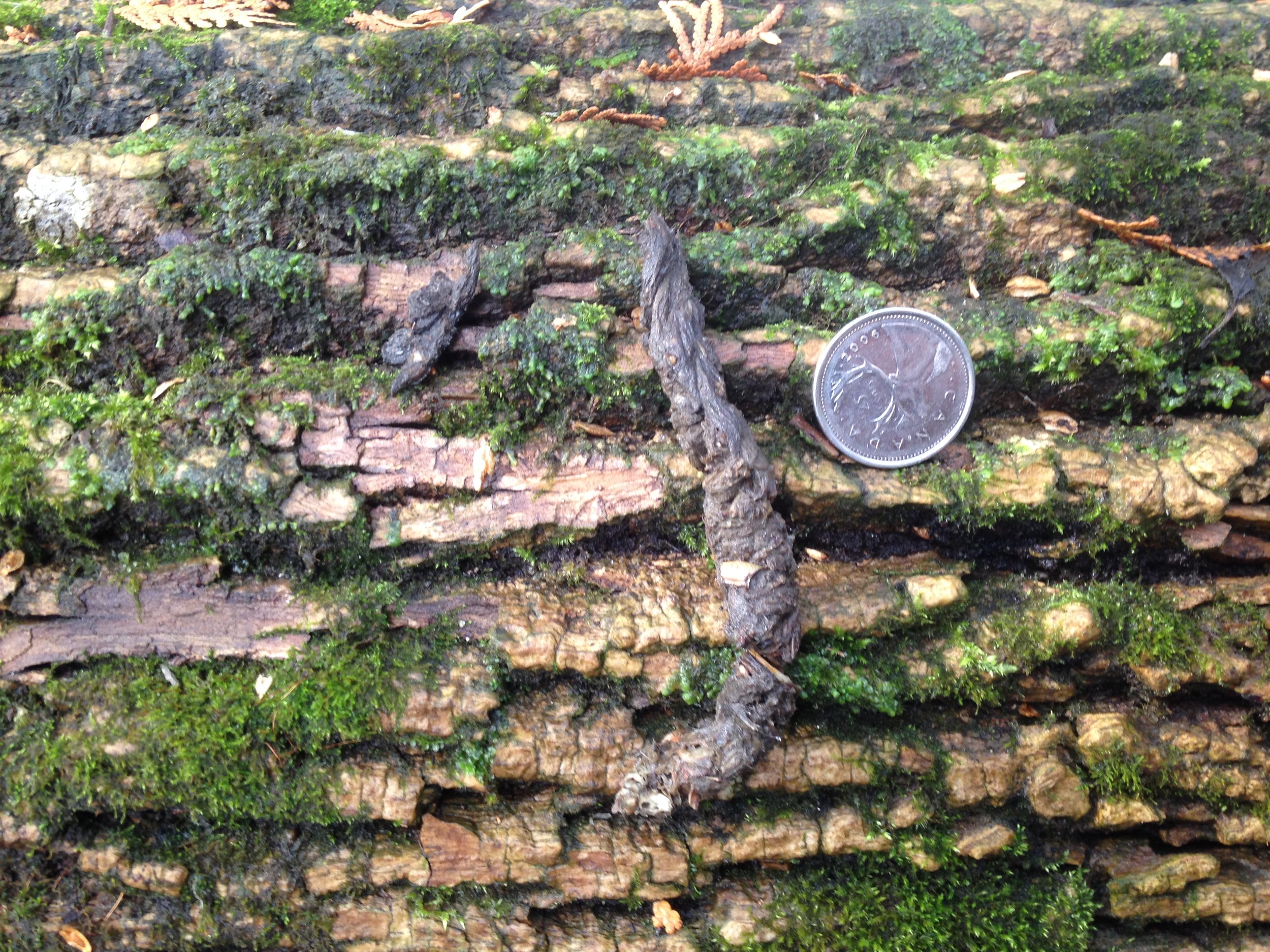
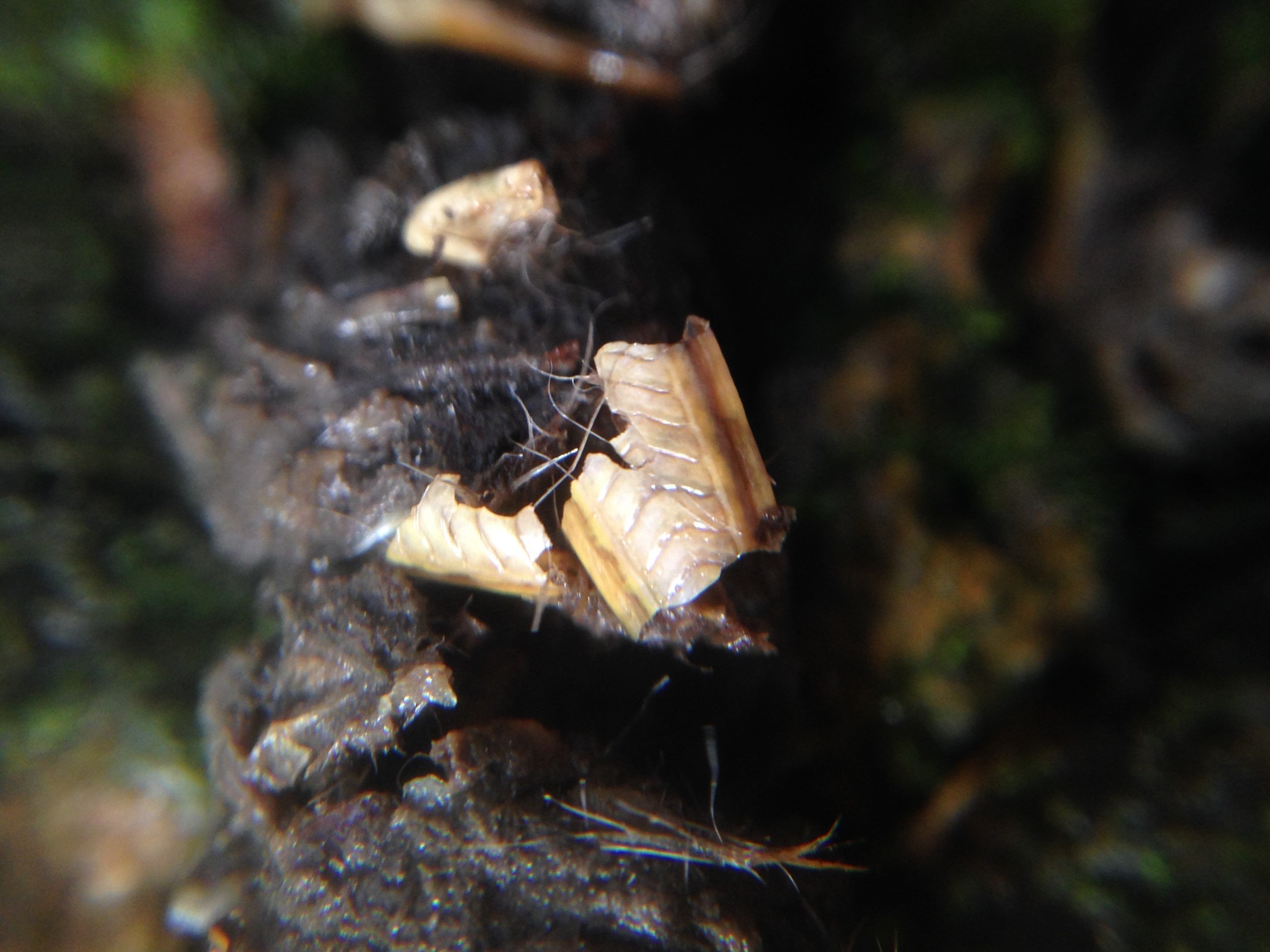
The scat was long, thin, twisted, and tapered, and pointed the end. The diameter of the scat at it’s widest was about 11 mm (7/16 in) and my notes are missing the length, which can always be a bit more variable, but with comparison to the coin (a canadian quarter measuring in at 23.88 mm) I think the scat is about 10 cm (~4 in) long. Considering the size and location of the scat, on a log right beside the river, I would assume it was deposited by a Mink. I didn’t really take the time to check out the other scats on the log because I was too enthralled with this particular load. I always find nearby sticks to pick apart scats because I can get a better understanding of who the animals may be eating, and that can help me understand a little more of who is present in the area, and where the animal who left the scat has been travelling. While picking through the scat with a couple of Cedar twigs I noticed some bone fragments. One of the fragments which I did not get a photo of as it was extremely small looked like it could have been the molars from the lower mandible of a juvenile White-footed/Deer Mouse (Peromyscus spp.). This is really a guess though as my field lens isn’t too powerful, it was only a small fragment, and I am not entirely familiar with all of the complex patterns of all mice and vole molars, but the molars didn’t quite resonate with the search image I have in mind for Meadow Vole (Microtus pennsylvanicus) or Southern Red Backed Vole (Clethrionomys gapperi). I’ll now have to try and pay more attention to the Mouse teeth I find.
Another interesting thing I discovered in the scat, was a fragment of what I think is the leg (inner medial area of the femur) of a Grasshopper (Melanoplus spp.)! I had watched a Two-lined Grasshopper (Melanoplus bivittatus) this summer near a pond I visit and had noted the ridges along the inner medial area after checking out the photos I took. Luckily due to this previous time of staring at photos of Grasshoppers for so long, I was able to identify this piece of the femur in the Mink scat! Nerds rejoice!
I never knew a Mink would consume a Grasshopper but it is now obvious that they do. This is part of the fun of breaking up the scat we find.
There were more scats nearby, include some Coyote and Deer scat. I was especially interested in the conversation around Deer scat as folks were trying to age it, so tell how long the scat had been there. Alexis was explaining that if we come across scat that looks fresh, maybe because it looks like it is still covered with mucus, with lines and ridges sort of like raisins, then the scat may not actually be as fresh as we might initially presume it to be. Instead it may be that the scat has dried out, then snowed over, then thawed. The moistness would come from the melted snow and the ridges and lines in the scat are from the drying, desiccating action before hand. This is helpful in the context of aging scat because I often come across Deer scat and take up the trail thinking it to be fresh. Perhaps now when I am out tracking and find the Deer scat I can look more carefully and decide whether the trail is too old to be of interest, or because sign seems to fade or breakdown over time, the new trail beyond the scat may be relatively easier to follow than the older trail.
We stopped under the shade of some Cedar trees for lunch shortly afterwards where we there was some discussion on what conversations were being had within the North American Cyber tracker, and general North American tracking cultural scene around decolonization, and what that looks like. There was a lot of storytelling around what folks had seen or experienced, what kinds or work is being done, or not being done, and a bit of reflection on what more can be done going forward. I think this is an ongoing conversation but someways I think we can help with the decolonization of the art and science of tracking is making it more accessible to more folks. I think teaching more people, through in person meet ups like the one I am writing about, or online like this blog, or in schools like I do for work is a good start, but it is also good to look at where these outlets don’t meet the needs or desires of those who want to learn, or whose capacity to learn in these ways has been structurally disabled. How do we go about creating the means for more tracking to be taught, shared, and spread? How do we change the ways we speak about, or go about the practice of tracking that welcomes the land and those who have been pushed from the lands we track on? Can tracking be a part of the #landback movement? How can settler trackers support indigenous communities? What can we learn by listening to and prioritizing the experiences of indigenous folks?
I know through some of my work, tracking has helped me see more deeply into the complex relationships that are always happening but I just didn’t have the eyes to understand the language. Could following animal trails and seeing the interwoven relationships help us braid and build new relationships with all our neighbours and relations? I think tracking can teach a land ethic that honours and respects the more-than-human, but we maybe need to learn how to be more reciprocal in how we practice in the first place? I think teaching the good ways and learning and doing the right things all come together. We have to practice better decolonial relationships to get better at decolonial relationships. As long as we are honest and willing to learn from our missteps than we can be moving towards healthier ways in being in relationship, and what a good practice to model that! To me, that is what tracking can be and sometimes is.
I think we all agreed that this is an ongoing conversation, and not something that is resolvable quickly. I take inspiration from the river we sat beside as we had this conversation. The flow will change, the course will change, the landscape around that river will change. Just as it can change over night, it also takes many seasons and even years to see some of the changes. As long as we keep focused on the need to change much of the dynamics at work between settlers and indigenous folks then hopefully we can find some good trails and follow them.
As we stood up to leave Alexis suggested that we move through quietly, giving everyone a chance to consider the conversation. We split up and wound around the base of the hill we were circumnavigating. There was a bit of mix up in the quiet and some made it to the top of a hill while it took others a couple of crow calls to get back there. I may have helped in the confusion by both indicating a ridge and a bridge, and not being too clear about either.
When we were back together at the top of a very windy ridge we kept on through a small ravine then up again only to spook a doe. We trailed her through the debris on the forest floor for a while and then I spooked her again at the top of the next hill. We all met up again to look at some Deer beds amid some old Apple trees and down in the a Cedar grove. It was getting a late in the day and I didn’t get too many photos, or even take too many notes.
Something did catch my eye on our way out along the trail. There was a small sized Beech (Fagus grandifolia) covered in what looked like white fungal blooms, but Rachelle, or was it Julia, explained that it wasn’t fungi. The white stuff was from an insect which was inhabiting the tree.
I had to take note of this. There had been mention many times of something killing Beech trees in the Eastern part of the continent, but I didn’t know much about it. Here was the sign, but what was causing it it? What was I looking at exactly?
It’s likely a case of Beech Bark Disease. Likely? I’ll get to that. But to share what I am learning, it’s a complex, meaning a couple of issues coming together to result in a larger issue. One of the components in the disease is a sap-feeding insect, Woolly Beech Scale (Cryptococcus fagisuga) which is from Europe, but was shipped to Halifax along with some European Beech (Fagus sylvatica) seedlings in the 1890’s. The other component of the complex is a couple of native fungi called Neonectria faginata and Neonectria ditissima. These fungi largely gain access to the Beech trees they infect through small wounds created by the Woolly Beech Scale insect and start colonizing the bark, cambium layer, and sapwood of the tree. One of the symptoms of the fungal infection are cankers, which are areas of dead tissue on the tree which slowly grow and can eventually damage and weaken the tree, rendering them easily snapped in high winds or storm events. If not a storm or wind, the cankers usually girdle the tree inhibiting the transfer of nutrients and the tree dies. I have read that the fungal spores from the infecting fungi may even hitch rides on the Woolly Beech Scale, likely infecting more and more trees as they go.
So the sign that we notice is the white goo on the tree. Looks like a fungi to me, but actually it is another case of an insect who exudes white waxy “wool” as mentioned earlier with the Woolly Ash Aphid. When the Beech trees are thoroughly infested, the wool pokes out of all sorts of wounds in the bark. If this white wax is not the fungal infection what does that look like? From the literature, it seems that fungi presents as clusters of small, deep red, flask-shaped structures in and around the cankers. I didn’t see this on the tree, only the waxy woolly exudate. So the fungus could be there, but I didn’t see it for sure. Someone with more experience then I have could probably look at the tree and tell, but I can’t yet. Soon… Another cool note is that there are no male Woolly Beach Scales. No males. None. Only females who reproduce by parthenogenesis. Life is amazing. New questions abound.
We wrapped up shortly afterwards and had a closing circle to go over the day in the parking lot of a Bruce Trail access point where one of the cars was parked at the beginning of the day. I was getting a little brain foggy by all trying to remember and process all of the things we had encountered though the day (so much more than I could ever try and write about), but also full of joy and motivation to learn more about some of those mysteries and discoveries. I love these tracking adventures because of that. Whole worlds within and adjacent to my own are revealed. Connections and webs of intimacy are exposed through careful observation of a crew of explorers, only to return home and see how strange and complex those webs and mysteries really are.
I just really love this stuff.
To learn more check out :
John Eastman, The Book of Field and Roadside (Stackpole Books, 2003), pg 292.
Close up footage of a Beaver chewing through a tree limb on youtube
Bugtracks blog entry on Woolly Aphids
University of Wisconsin Field Station post on Woolly Aphhids
Characteristics of the Pelvic Girdle in Relation to Sex in Black-Tailed and White-Tailed Deer : California Fish and Game Vol 42, N. 1, Jan. 1956.
A quick and easy explanation of the ilio-pectineal eminence (IPE) and how to sex the Deer
Pelvic Girdle Criteria for Sex Determination of White-Tailed Deer by J. Kenneth Edwards, R. Larry Marchinton and Gladys F. Smith : Paywalled JSTOR article
Invasive Species Centre info page on Beech Bark Disease
Biology and Managementof Beech Bark Disease
Beech Bark Disease in Ontario: A Primer and Management Recommendations

